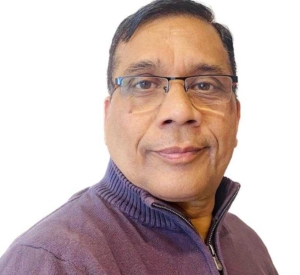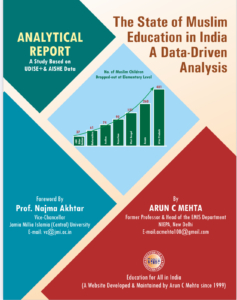Challenges of Small Schools in India: An Analysis of UDISE+ 2024-25 Enrolment Data
Implications for Universal School Education by 2030
Introduction
The NEP 2020, approved on July 29, 2020, introduces a transformative 5+3+3+4 structure, replacing the 10+2 system, to align education with developmental stages: Foundational (ages 3–8), Preparatory (ages 8–11), Middle (ages 11–14), and Secondary (ages 14–18). Samagra Shiksha, the flagship program for school education, operates under a unified planning framework to achieve these goals. However, UDISE+ data for 2023-24 and 2024-25 indicates that 36.4% of schools in 2024-25 have ≤ 50 students, often in rural or remote areas, facing distinct challenges like teacher shortages and inadequate infrastructure. Previous advocacy on Education for All in India called for NIEPA to develop phase-specific planning modules for NEP 2020’s stages. This article extends that recommendation, urging NIEPA to create a dedicated planning module for small schools, integrated with phase-specific strategies, to address their unique needs and support universal education by 2030.
State-specific Schools by Enrolment Slabs UDISEPlus 2024-25 [pdf]
As the prime duty of the Education for All in India website, we undertake detailed analysis of UDISE+ data whenever it is released. A large number of extensive articles are available on this website based on 2021-22 to 2024-25 data, which have benefited many researchers, policymakers, and educators across India and beyond.
To visualize the distribution of schools by enrollment slabs for 2024-25 at the national level, Figure 1 presents a line graph illustrating the cumulative percentage of schools across detailed slabs, highlighting the concentration in lower enrollment categories.
Methodology
This study analyses UDISE+ data for 2023-24 and 2024-25 from the Department of School Education and Literacy, Ministry of Education, India. Enrollment slabs are reclassified into five categories (≤ 30, 31–50, 51–100, 101–400, >400) to focus on small schools (≤ 50). National and state-level trends are examined, with selected states (Bihar, Himachal Pradesh, Uttar Pradesh, Tamil Nadu, Ladakh) chosen for their diverse contexts. Changes in enrollment distributions are calculated as percentage point differences, and absolute numbers of schools are derived using total school counts (e.g., for 2024-25, total schools = 1,471,473). The analysis incorporates NEP 2020 and Samagra Shiksha guidelines, reviewed via official documents (https://www.education.gov.in and https://samagrashiksha.gov.in), and builds on prior recommendations from Education for All in India for phase-specific planning. Limitations of uniform planning and challenges of small schools are assessed using UDISE+ data and secondary sources, including Mehta (2025).
Analysis of Enrollment Trends
National-Level Trends
The total number of schools remained nearly constant, with 1,471,891 in 2023-24 and 1,471,473 in 2024-25, a marginal decline of 418 schools. In 2023-24, 302,922 schools (20.6%) had enrollment ≤30, while in 2024-25, this number increased to 326,747 schools (22.2%), an addition of 23,825 small schools. Similarly, schools with 31–50 students numbered 210,166 (14.3%) in 2023-24 and 208,949 (14.2%) in 2024-25, a slight decrease of 1,217 schools. Table 1 shows the reclassified enrollment distribution, including absolute numbers for 2024-25.
| Enrollment Slab | 2023-24 (%) | 2024-25 (%) | 2024-25 Number of Schools | Change (Percentage Points) |
|---|---|---|---|---|
| ≤ 30 | 20.6 | 22.2 | 326,747 | +1.6 |
| 31–50 | 14.3 | 14.2 | 208,949 | -0.1 |
| 51–100 | 16.3 | 15.9 | 233,962 | -0.4 |
| 101–400 | 34.1 | 33.0 | 485,585 | -1.1 |
| >400 | 14.7 | 14.7 | 216,230 | 0.0 |
Observations:
- Increase in Small Schools: The number of schools with ≤30 students rose from 302,922 to 326,747, an increase of 23,825 schools, indicating a growing challenge for resource allocation and potentially signalling declining enrollment in existing small schools due to migration or dropouts.
- Stability in Larger Schools: Schools with 31–50 students decreased slightly from 210,166 to 208,949, while those with >400 students remained stable at around 216,000. Mid-sized schools (51–100 and 101–400) saw declines of about 6,000 and 16,000 schools, respectively, suggesting possible consolidation efforts.
- NEP 2020 Implications: The rise in small schools (total ≤50: 535,696 in 2024-25, or 36.4%) complicates achieving foundational literacy and numeracy (FLN) by 2025, as these schools often lack resources for NEP’s play-based and activity-based pedagogies. Figure 2 illustrates the bar chart comparison of absolute numbers across slabs for 2024-25.>400
State-Level Trends
State-level variations highlight regional disparities. For instance, in Bihar, schools with ≤30 students increased from 2,272 (2.4% of 94,686) in 2023-24 to 4,191 (4.4% of 94,339) in 2024-25, adding 1,919 such schools amid concerns of rural depopulation. Himachal Pradesh saw a stable but high number of 8,512 schools (49.1% of 17,330) with ≤30 in 2024-25. Table 2 presents percentages and 2024-25 absolute numbers for selected states.
| State/UT | Year | ≤ 30 (%) | 31–50 (%) | 51–100 (%) | 101–400 (%) | >400 (%) | 2024-25 Total Schools | 2024-25 ≤30 Schools |
|---|---|---|---|---|---|---|---|---|
| Bihar | 2023-24 | 2.4 | 5.8 | 13.2 | 54.6 | 24.0 | – | – |
| 2024-25 | 4.4 | 7.2 | 12.0 | 52.8 | 23.6 | 94,339 | 4,191 | |
| Himachal Pradesh | 2023-24 | 48.9 | 10.3 | 6.9 | 16.5 | 17.4 | – | – |
| 2024-25 | 49.1 | 9.9 | 6.5 | 16.9 | 17.6 | 17,330 | 8,512 | |
| Uttar Pradesh | 2023-24 | 10.7 | 13.1 | 16.1 | 40.6 | 19.5 | – | – |
| 2024-25 | 12.4 | 13.6 | 15.5 | 38.0 | 20.5 | 262,358 | 32,532 | |
| Tamil Nadu | 2023-24 | 26.5 | 8.9 | 9.3 | 28.5 | 26.8 | – | – |
| 2024-25 | 28.3 | 8.8 | 9.0 | 27.5 | 26.4 | 57,935 | 16,397 | |
| Ladakh | 2023-24 | 65.6 | 8.0 | 4.5 | 9.4 | 12.5 | – | – |
| 2024-25 | 64.2 | 8.0 | 4.9 | 9.6 | 13.3 | 961 | 617 |
Observations
- Bihar: The number of schools with ≤30 students doubled to 4,191 in 2024-25, reflecting challenges in rural retention despite 22,264 large schools (>400).
- Himachal Pradesh: With 8,512 schools (49.1%) having ≤30 students in 2024-25, the state’s mountainous terrain exacerbates isolation, making phase-specific interventions vital.
- Uttar Pradesh: Schools with ≤30 rose to 32,532 (12.4%), while large schools (>400) numbered 53,733 (20.5%), indicating urban-rural polarization.
- Tamil Nadu: An increase to 16,397 small schools (≤30, 28.3%) signals rural enrollment declines, with 15,290 large schools (>400).
- Ladakh: 617 schools (64.2%) with ≤30 students in 2024-25 highlight extreme remoteness, with only 128 large schools (>400). Figure 3 compares the proportion of small schools (≤30) across these states in 2024-25.
Limitations of Uniform Planning
The Samagra Shiksha’s single planning module overlooks the diverse needs of small schools and NEP 2020’s phases:
- Resource Misallocation: Small schools (e.g., 326,747 with ≤30 in 2024-25) receive funding disproportionate to their low enrollment (potentially serving <10 million students), while larger schools (216,230 with >400) face shortages despite educating millions.
- Teacher Deployment Challenges: UDISE+ 2023-24 reports 110,971 single-teacher schools, particularly affecting Foundational and Preparatory stages, where play-based learning requires specialized training.
- Infrastructure Gaps: Small schools often lack digital tools and facilities mandated by NEP 2020 for Middle and Secondary stages, such as coding and vocational labs.
- Phase-Specific Needs Ignored: The Foundational stage’s play-based pedagogy and the Secondary stage’s subject flexibility require distinct resources, which a uniform module cannot address effectively for the 535,696 small schools (≤50).
- Regional Disparities: States like Ladakh (617 small schools ≤30) and Himachal Pradesh (8,512) need localized strategies, unlike urban-centric states like Bihar (4,191 small schools).
Challenges Faced by Small Schools
Small schools face systemic issues that hinder NEP 2020’s goals:
- Teacher Shortages: Single-teacher schools (7.54% nationally in 2023-24, affecting ~4 million students) struggle with multi-grade teaching, impacting FLN goals in the Foundational stage.
- Infrastructure Deficits: Many of the 326,747 small schools (≤30 in 2024-25) lack toilets, electricity, and digital resources, limiting Middle and Secondary stage reforms like coding and experiential learning.
- Economic Inefficiency: High per-pupil costs in small schools (e.g., potentially 2-3 times higher than in large ones) strain budgets, reducing investments in teacher training and infrastructure.
- Retention Issues: Low enrollment correlates with high dropout rates (e.g., in Bihar’s 4,191 small schools), particularly in rural areas, undermining universal access.
- Phase-Specific Challenges: Small schools struggle to implement play-based learning (Foundational), discovery-oriented teaching (Preparatory), critical thinking (Middle), and subject flexibility (Secondary) due to resource constraints, as seen in Ladakh’s 617 isolated schools.
Recommendations for NIEPA
Building on prior advocacy at Education for All in India, NIEPA should develop:
- A Dedicated Planning Module for Small Schools:
- Teacher Allocation: Train teachers for multi-grade teaching, tailored to Foundational and Preparatory stages, using platforms like DIKSHA, targeting the 535,696 small schools (≤50 in 2024-25).
- Cluster-Based Resource Sharing: Implement NEP 2020’s school complex model to share labs and libraries, supporting Middle and Secondary stages for states like Himachal Pradesh (8,512 small schools).
- Cost-Effective Infrastructure: Prioritize modular facilities for small schools, aligning with phase-specific needs (e.g., play areas for Foundational stage in Tamil Nadu’s 16,397 small schools).
- Community Engagement: Strengthen School Management Committees to boost retention, especially in rural Uttar Pradesh (32,532 small schools).
- Data-Driven Monitoring: Use UDISE+ student-wise data to track phase-specific outcomes in small schools, such as FLN in Bihar’s 4,191 small schools.
- Phase-Specific Planning Modules:
- Foundational Stage (Ages 3–8): Focus on ECCE with play-based resources and teacher training for language and numeracy, adapted for small schools.
- Preparatory Stage (Ages 8–11): Emphasize discovery-oriented teaching with flexible curricula and mother-tongue instruction.
- Middle Stage (Ages 11–14): Introduce coding and experiential learning, supported by digital infrastructure in clustered small schools.
- Secondary Stage (Ages 14–18): Enable subject flexibility and vocational training, requiring specialized teachers and facilities.
Alignment with NEP 2020 and Samagra Shiksha
NEP 2020 prioritizes FLN by 2025 and universal GER by 2030, with Samagra Shiksha funding infrastructure, teacher training, and digital learning for all 1,471,473 schools. However, the lack of specific guidelines for small schools (36.4% of total) and phase-specific planning limits progress, particularly in high-small-school states like Ladakh. A dedicated module for small schools, integrated with phase-specific strategies, would ensure equitable access and quality, optimizing resources for the 326,747 schools with ≤30 students.
Concluding Observations
UDISE+ data reveals a rise in small schools, with 326,747 (22.2%) having ≤30 students in 2024-25, up from 302,922 (20.6%) in 2023-24—an increase of 23,825 such schools. States like Ladakh (617 small schools, 64.2%) and Himachal Pradesh (8,512, 49.1%) highlight the urgency of tailored interventions, while even populous states like Uttar Pradesh (32,532 small schools) show growing disparities. NIEPA must lead in developing both a small schools module and phase-specific modules to align with NEP 2020’s 5+3+3+4 structure. This dual approach will enhance resource efficiency, teacher effectiveness, and student outcomes, advancing universal education by 2030 for all 1.47 million schools.
Suggested Readings
- Department of School Education and Literacy, Ministry of Education, India. (2023-24). UDISE+ Report. https://udiseplus.gov.in
- Department of School Education and Literacy, Ministry of Education, India. (2024-25). UDISE+ Report. https://udiseplus.gov.in
- Mehta, A. C. (2025). Analysis of UDISEPlus 2022-23 and 2023-24 Data: Understanding Trends and National Education Goals. Education for All in India. https://educationforallinindia.com
- Ministry of Education, Government of India. (2020). National Education Policy 2020. https://www.education.gov.in
- Samagra Shiksha Guidelines. Department of School Education and Literacy, Ministry of Education. https://samagrashiksha.gov.in
- National Institute of Educational Planning and Administration (NIEPA). (2023). Educational Planning: Concept & Methodology. https://www.niepa.ac.in
Note: This analysis is part of an ongoing series on UDISE+ data, contributing to evidence-based education policy in India.


